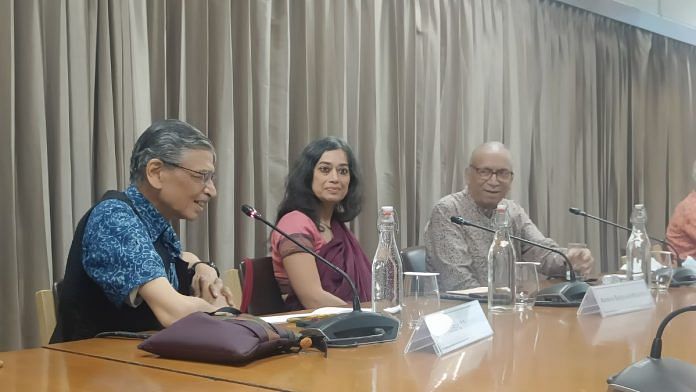New Delhi: It’s thanks to the architecture and urban planning of Jaisalmer that the Golden City of India has withstood the unforgiving wrath of the Thar Desert’s summer heat for centuries.
“When we talk about urban design today, it’s about the plantation which will keep us cool. In Jaisalmer, there are hardly any trees. It’s the dense construction that enabled them to have lower temperatures within the city,” said Vinod Gupta, professor and architect, at the panel discussion, ‘Learning from Jaisalmer’, at Delhi’s India International Centre (IIC) on 28 March.
Gupta measured the temperature of Jaisalmer extensively, from havelis and streets to the Bhunga area (open spaces populated by mud houses), as part of his PhD research at IIT Delhi in the 1980s. He found that Jaisalmer’s urban parts were cooler than recorded meteorological data—unlike today’s urban heat islands.
“The temperature in the city was actually lower than the temperature recorded by the meteorological department, which is quite the opposite of what we are seeing today in other cities,” said Gupta.
He gave the credit to the city’s shaded courtyards, intricate jali work in the construction, and ventilation shafts that naturally keep temperatures lower.
Gupta was joined by Snehanshu Mukherjee, professor at the Indian Institute of Art and Design, Delhi, and Anisha Shekhar Mukherji, conservation architect and moderator of the talk. Among the audience were architecture enthusiasts and architects.
Experts at the event stressed the need to learn from traditional designs to create climate-responsive cities, as modern buildings often fail to offer the same thermal comfort.
“The session tried to identify the problems in mainstream architecture today and to suggest ways of overcoming those problems, and offer possible alternatives to the way we generally design, construct, or inhibit architecture,” said Mukherji.
Designing ventilation
Two of Vinod Gupta’s professors were fond of Jaisalmer, which led him to the narrow streets of the desert town for his research. Till then, nobody had tried to find out how the town planning and building design worked to moderate temperature in the city.
When Gupta showed his work on Jaisalmer in England, the audience had a question: What is so special about the city’s plan? The layout of London is similar, with its strategic use of courtyards.
But Gupta had an answer for his British audience. In Jaisalmer, the courtyards are placed within individual buildings in such a manner that all the rooms open to them.
“Courtyards provide a channel of communication. It was a social space for, say, an extended family to talk to each other. They are an active floor space, particularly in smaller houses,” said Gupta.
People also used shafts, vertical ducts, and jali carvings to keep their houses cool.
“The jali carving provided a lower temperature indoors. All the solar radiation was shed off by its fins,” Gupta added. The decorative jalis, therefore, served a utilitarian purpose.
While Gupta took the readings in the city, his respondents expressed comfort even in 33 degrees Celsius.
Professor Snehanshu Mukherjee, who also accompanied Gupta on some of his Jaisalmer visits, recalled a story of a man who chose to build a modern house in Jaisalmer over a traditional one with all the ventilation. He was inspired by other modern houses in Jaipur. But his father spent his days outside the new house to escape the heat inside. Even desert coolers couldn’t keep the house cool in Jaisalmer’s heat.
“That poor man was cursing his son for demolishing the old one.”
(Edited by Prasanna Bachchhav)






